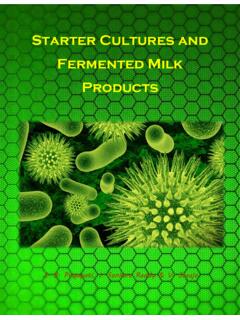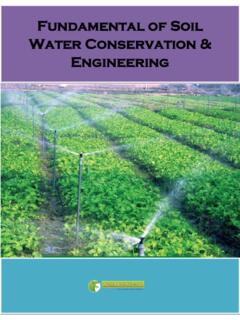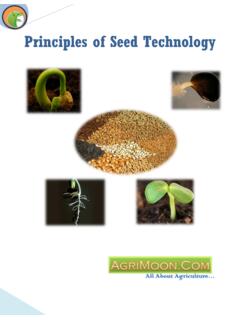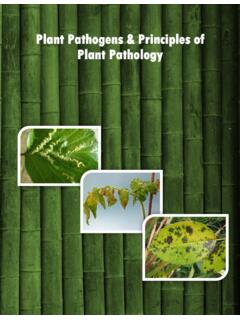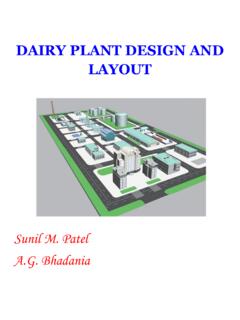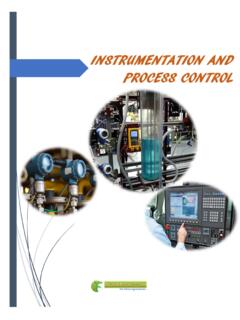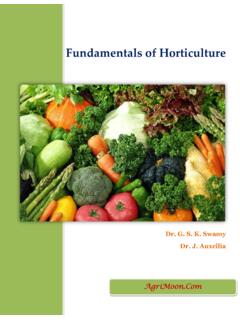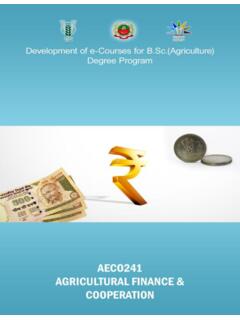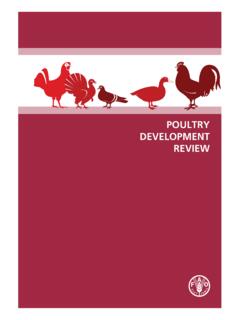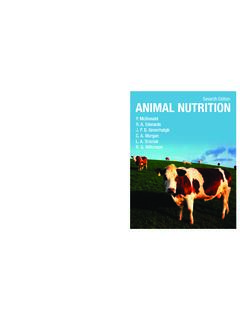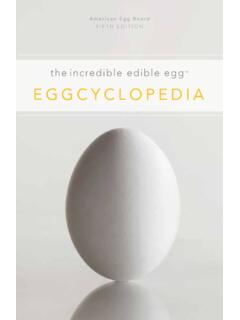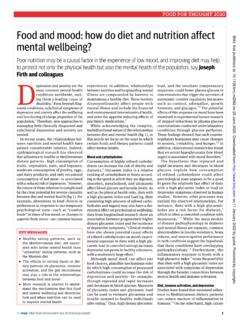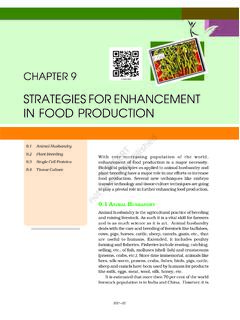Transcription of LIVESTOCK PRODUCTION MANAGEMENT - AgriMoon
1 LIVESTOCK PRODUCTION & MANAGEMENT LIVESTOCK PRODUCTION and MANAGEMENT This eCourse Developed By TNAU (ICAR) INDEX SN Chapter Page No 1 Prelusion-Significance of LIVESTOCK and poultry in Indian economy- LIVESTOCK and poultry census - role of LIVESTOCK and poultry in Indian agriculture. 1-5 2 Various systems of LIVESTOCK PRODUCTION -extensive - semi intensive- intensive mixed. 6-9 3 Integrated Farming systems- Role of LIVESTOCK and poultry , manure MANAGEMENT methods, Duck/Fish/Rice Culture. 10-12 4 Definition of breed-classification of indigenous, exotic cattle and buffaloes Breed characteristics of Sindhi, Kangayam and Umblacherry, Jersey, Holstein Friesian, Murrah and Surti. 13-19 5 Breeding- importance of cross breeding. Signs of estrous cycle-Artificial insemination merits and demerits. 20-25 6 Housing MANAGEMENT -farm site selection-space requirement for calves, heifer, milch animal and work bullocks-Type design of house.
2 26-28 7 Systems of housing-Single row system-Double row system- head to head and tail to tail-merits and demerits. 29 8 Care and MANAGEMENT of new born calf and heifers. 30-34 9 Care and MANAGEMENT of pregnant, lactating animals and work bullocks. 35-37 10 Milk-Definition clean milk PRODUCTION -methods of milking hand and machine milking. Preservatives and common adulterants of milk. 38-57 11 Processing of milk-Cooling-Pasteurization-Definition-V arious methods-Low Temperature Long Time, High Temperature Short Time and Ultra High Temperature-advantages and disadvantages. 58-67 12 nutrition -Definition-Ration-Balanced ration-Desirable characteristics of a ration. 68-70 13 Requirement and importance of green fodder, carrying capacity and forage cycle. 71-97 14 Diseases-classification-viral, bacterial and metabolic-General control and preventive measures. 98-99 15 Viral diseases- Foot and Mouth- Bacterial diseaseanthrax, haemorrhagic septicemia and Black quarter- Metabolic- Tympanites, Ketosis and Milk fever.
3 Mastitis and its control, Foot and Mouth Disease. 100-108 16 Zoonotic diseases prevention and control (Anthrax, Tuberculosis, Brucellosis, and Rabies) 109-112 17 Sheep and Goat Farming Classification of Breeds of Indian and exotic origin-nomenclature alone. 113-124 18 Systems of rearing-Housing MANAGEMENT - Type design- Floor diagram-Space Requirement for adult and young stock. 125-127 19 Care and MANAGEMENT of ram, ewe and lamb- nutrition Feeds and fodder for small Ruminants. 128-135 20 Care and MANAGEMENT of Buck, DOE and kid- nutrition Flushing. 136-143 21 Common ailments of sheep and goat-Sheep pox-Foot and Mouth-Blue tongue- Enterotoxaemia Ecto and Endo parasites. 144-145 22 Swine Husbandry Common breeds of exotic origin-nomenclature alone housing of pigs. 146-164 23 Care and MANAGEMENT of Sow, Boar and Piglets- nutrition - Creep feeding. Control and prevention of swine diseases Hog cholera, Foot and mouth, Ecto and Endoparasites.
4 165-183 24 Classification of poultry viz. layer, broiler and dual purpose- Nomenclature of commercial layer and broiler strains. 184-187 25 Care and MANAGEMENT of day old chicks-Brooder MANAGEMENT . 188-194 26 Systems of housing- Deep litter and cage systems merits and demerits. 195-201 27 Raised Platform housing- Floor space Requirement- Litter MANAGEMENT . 202-206 28 Care and MANAGEMENT of layers. 207-208 29 Care and MANAGEMENT of broilers. 209 30 poultry nutrition -Feed formulation-composition of chick mash grower, layer, broiler starter and finisher mashes. 210-213 31 Feed Conversion Ratio / dozen eggs or kilogram of meat. Marketing channels in poultry -Integration. 214-220 32 Classification of poultry diseases-Viral-Bacterial-Protozoan- causative organisms, symptoms and prevention Viral diseases Ranikhet disease Infectious bursal disease. 221-227 33 Bacterial Coccidiosis causative organism symptoms and preventive measures.
5 Nutritional deficiency diseases and its control. 228-230 Lec1: Prelusion-Significance of LIVESTOCK and poultry in Indian economy- LIVESTOCK and poultry census - role of LIVESTOCK and poultry in Indian agriculture. LIVESTOCK farming is an integral part of crop farming and contributes substantially to household nutritional security and poverty alleviation through increased household income. The returns from LIVESTOCK especially dairying and mixed farming in small and medium holdings are larger and highly sustainable. The progress in this sector results in more balanced development of the rural economy and improvement in economic status of poor people associated with LIVESTOCK . Indian agriculture is an economic symbiosis of crop and LIVESTOCK PRODUCTION with cattle as the foundation. Dairy animals produce milk by converting the crop residues and by products from crops which otherwise would be wasted.
6 Dairy sector contributes by way of cash income, draught power and manure. LIVESTOCK provides for human needs by way of 1. Food 2. fibre. 3. Fuel. 4. Fertilizer. Skin and 6. Traction. It is a living bank providing flexible finance in time of emergencies and also serves as insurance against crop failure for survival. If Agriculture is the foundation of our national economy Animal husbandry constitutes the sheet anchor of agriculture. Indian agriculture marches on the patient back of the bullock. 70 percent of the LIVESTOCK are owned by 67 percent of small and marginal farmers. 76 percent of the milk is produced by weaker sections of society. One fifth of the worlds LIVESTOCK population is present in India . India has nearly 57 % of the worlds buffalo population, 16% of the cattle population, 20% of goat population and 5 % of sheep population although India constitutes less than 3 % of the worlds total land area.
7 Population of LIVESTOCK and poultry in India and Tamilnadu CATTLE MILLION & MILLION Buffaloes Million & Million Goat Million & Million Sheep Million & Million Pig Million & Million poultry 3430 Million & 240 Million. The PRODUCTION Parameters are LIVESTOCK PRODUCTION and 81 Million tonnes ( 00 01 ) I in the world ( contributing 14% of the world milk PRODUCTION ) Billion eggs 5th in the world million kgs of wool million tonnes of meat Per capita Milk availability is 221 gms / day ( 00 01 ) whereas the requirement is 280 gms / day Per capita egg availability is 33 eggs/ year whereas the requirement is 180 eggs Per capita availability of poultry meat is 700 gms/ annum whereas the requirement is 10 kgs/ annum. It is estimated that about 18 million people are employed in the LIVESTOCK sector in principle or subsidiary status.
8 Export earnings from LIVESTOCK sector and related products are progressively rising. Finished leather accounted for 50 % ( crore ) and meat and meat products accounted for 42 %(Rs1457 crore) of the total export from the LIVESTOCK sector during 2000-01. The contribution of LIVESTOCK sector to the total Gross domestic product (GDP) was in 00-01, accounting for 27 % of total agricultural output. Though the cattle wealth is quite abundant in terms of population the PRODUCTION from these animals is very poor viz., 987 kgs per lactation whereas the world average is 2038 kgs per lactation. The main reasons for this shortcoming is the abundant population of nondescript cows, chronic shortage of feed and fodder, poor nutritive value of the available feed and fodder, low fertility rates, destruction of grazing land, increasing human population and competition between animals and man for the available feed resources.
9 To satisfy the nutrient requirement for the huge population of LIVESTOCK the options are reduce the unproductive/ low productive animals. 2. feeding of non conventional feed stuffs among these are the horticultural by products like agriculture by products, vegetable wastes and horticulture industrial wastes. LIVESTOCK PRODUCTION and 2 First step that bridges LIVESTOCK and agriculture is the efficient utilization of agriculture/horticulture waste to feed animals and convert to high quality meat, milk, wool, egg etc., Second linkage is through application of organic fertilizers to crops. The third application is the usage of draught animal power for ploughing of land. Nutrient content of animal and poultry manure Nutrient Nutrient content of manure (mg g dry weight-1) Cattle Sheep Pig Horse poultry Nitrogen 25-40 20-45 20-45 17-30 28-62 Phosphorus 4-10 4-11 6-12 3-7 9-29 Potassium 7-25 20-29 15-48 15-18 8-29 Calcium 5-8 8-19 3-20 7-29 17-69 Magnesium 5-8 3-6 2-3 3-5 3-8 Sulphur 3-4 2-3 3-5 1-3 4-7 Apart from manurial value biogas can be produced from LIVESTOCK dung and poultry droppings.
10 32 kg of cow dung/20 kgs of pig faeces/12 kgs of poultry droppings can produce 1 m3 34 cft of bio gas. the calorific value of bio gas 500 to 700 BTU per cft in comparison to Natural gas 850 BTU/cft. 1 m3 of slurry fed to biogas plant produces on an average to m3 of biogas daily. Based on equivalent effective heat produced 2 m3 biogas plant replaces in a month fuel equivalent of 26 kgs of LPG contained in standard gas cylinder or 37 litres of kerosene or 88 kgs of charcoal or 210 kgs of fuel wood or 740 kgs of animal dung. 1. 83 million draught animals 2. The power generated from 83 million draught animals is equivalent to 30,000 million watts in terms of electic power 3. ha area of land is cultivated by the animals. The power rating of a full grown bullock a pure Indian draught breed is HP average is is Hp only. A35 Hp tractor can plough about of land in an eight hour shift and consume about 5l diesel / hr.
